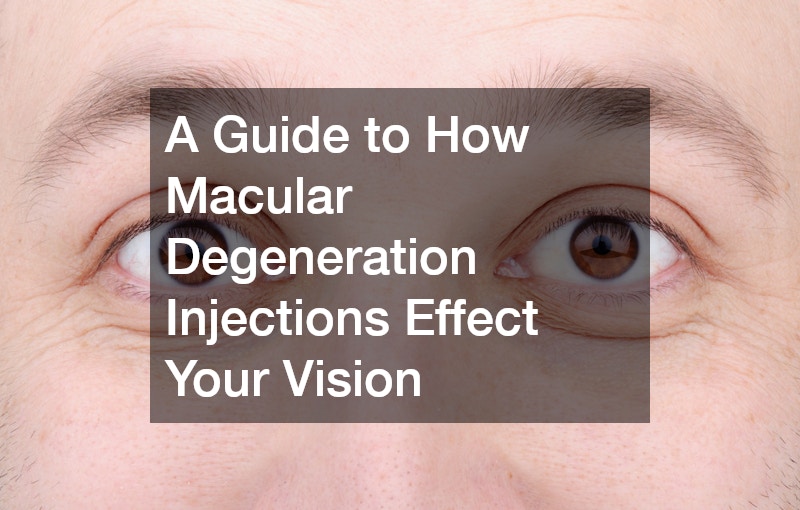
Macular degeneration is a leading cause of vision loss, particularly in older adults. This progressive eye condition primarily affects the macula, the central part of the retina responsible for clear vision. While there is no cure for macular degeneration, treatments like macular degeneration injections have shown to be effective in managing the condition and slowing its progression. In this guide, we’ll explore how macular degeneration injections affect your vision, their mechanism of action, and what to expect from this treatment.
Understanding Macular Degeneration and the Need for Injections
Macular degeneration occurs when the macula, which is responsible for sharp, central vision, becomes damaged. There are two main types of macular degeneration: dry and wet. Dry macular degeneration progresses slowly and leads to gradual vision loss. Wet macular degeneration, however, is more aggressive and involves the growth of abnormal blood vessels under the retina, which can leak fluid and cause rapid vision deterioration.
In the case of wet macular degeneration, macular degeneration injections are typically the recommended treatment. These injections aim to block the abnormal blood vessel growth and reduce fluid leakage, which helps slow the loss of central vision. The injections target a protein called vascular endothelial growth factor (VEGF), which plays a crucial role in the growth of these abnormal blood vessels.
How Do Macular Degeneration Injections Work?
Macular degeneration injections involve the administration of anti-VEGF medications directly into the eye. These medications, such as ranibizumab, aflibercept, and bevacizumab, work by blocking the action of VEGF. When VEGF is inhibited, the abnormal blood vessels beneath the retina are unable to grow and leak fluid, which helps to reduce damage to the macula.
By targeting the underlying cause of wet macular degeneration, macular degeneration injections can stabilise vision and, in some cases, improve vision. However, it’s important to note that these injections are not a cure for the condition; they can only manage its symptoms and slow the progression of vision loss. Regular injections are often required to maintain the benefits, and treatment schedules may vary depending on the severity of the condition and the patient’s response.
What to Expect After a Macular Degeneration Injection
The procedure for receiving a macular degeneration injection typically takes only a few minutes, though you will need to visit your ophthalmologist for regular appointments. Before the injection, the eye will be numbed with a local anaesthetic to ensure minimal discomfort. Your doctor will then carefully inject the medication into the vitreous gel of the eye, which is the area in front of the retina.
After the injection, patients may experience some temporary side effects, such as mild discomfort, redness, or blurred vision. These side effects usually resolve within a few hours or days. In rare cases, more serious side effects such as infection or retinal detachment may occur, but these are extremely uncommon. It’s important to follow your ophthalmologist’s post-treatment instructions to reduce the risk of complications and to ensure proper healing.
How Macular Degeneration Injections Affect Your Vision Over Time
Immediately after receiving a macular degeneration injection, patients may notice a temporary blurring of vision, but this typically improves over time. The effects of the injection are not instant; it can take a few weeks to a couple of months for patients to notice improvements or stabilisation of their vision. Regular follow-up visits are crucial to monitor the effectiveness of the injections and determine whether further treatments are needed.
For many patients, macular degeneration injections help to slow the progression of vision loss, maintaining central vision and improving quality of life. In some cases, vision may improve slightly, particularly if the injections are started early in the disease progression. However, it’s important to remember that the injections cannot reverse the damage that has already occurred to the macula. They are designed to manage the condition and prevent further deterioration.
Frequency of Injections and Long-Term Effects
The frequency of macular degeneration injections can vary depending on the individual’s condition. Initially, patients may need to have injections every month or two, but as the condition stabilises, the frequency may be reduced. Some patients may require injections every three months or even longer. Your ophthalmologist will tailor the treatment schedule based on your specific needs and how well the injections are working.
Over time, the need for injections may decrease, and some patients may reach a point where they no longer require them. However, for many people with wet macular degeneration, ongoing treatment is necessary to maintain the benefits and prevent further vision loss.
Macular degeneration injections play a crucial role in managing wet macular degeneration and preserving vision. By targeting the abnormal blood vessels that contribute to vision loss, these injections can stabilise vision, slow the progression of the condition, and, in some cases, improve vision. While the injections are not a cure, they are a vital part of the treatment plan for those suffering from macular degeneration. With regular follow-ups and adherence to the treatment plan, patients can maintain their vision and quality of life for as long as possible. Always consult your ophthalmologist to determine the best course of action for your individual needs.
.




